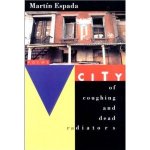 City of Coughing and Dead Radiators, book by Martin Espada
City of Coughing and Dead Radiators, book by Martin Espada
Annotation by Xochitl-Julisa Bermejo
City of Coughing and Dead Radiators by Martin Espada is what I like to call allegorical poetry. Allegory is a narrative with characters, places, and objects that represent themselves as well as abstract ideas for the purpose of teaching a moral or stating a higher truth. Espada’s collection holds strong narratives that move between El Salvador, Puerto Rico, and urban centers of the East Coast while revolving around themes like the divide between the working and ruling classes, immigration, and the modernism of America. It is his themes and narratives working with geography and culture that make the allegory an exciting form.
One way Espada creates allegory is through the use of characters that represent abstractions. From “The Toolmaker Unemployed:” “The toolmaker / is sixty years old, / unemployed / since the letter / from his boss / at the machine shop” (50). The character of the toolmaker is symbolic of powerlessness of the low-income laborer who imagines, “a bullet / in the forehead, / maybe for himself, / maybe for the man / holding the second mortgage” (51). Other characters like the judge, the landlord, and the lawyer, representing the ruling class, are foils for the toolmaker, Rosa Ramos, and the ex-mental patient, characters representing the working class. Thus, through these characters Espada unveils the tensions between the classes as well as between the immigrant dream and the immigrant reality.
Symbolism is integral to allegory. In “The Skull Beneath the Skin of the Mango,” Espada writes, “An American reporter, / arms crowded with fruit, / could not see what he kicked jutting from the ground. / He glanced down and found his sneaker / pressing against the forehead / of human skull, yellow / like the flesh of a mango. // He wondered how many skulls are crated with the mangoes for sale at the market, how many grow yellow flesh and green skin” (34-35). Here the skull is a symbol for the violence-death squads, desaparecidos, dictators-in Central America, and the mango is a symbol for our (Americans) connection to this violence by the produce we buy at our corner supermarket that, unknown to us, supports tyrannical regimes in other parts of the world (For example, United Fruit Company in Guatemala). Gregory Orr says in Poetry as Survival: “Symbols can order the conflicts within a poem (including the tension of disorder and order) by concretely presenting them in a single, physical object” (Orr 104). The mango fruit juxtaposed with the skull makes a frightening connection by bringing the violence from “out there” inside the safety of the home, and makes oppression concrete for the reader.
Catholic symbols are prevalent in the collection. For example, in “Who Burns of the Perfection of Paper,” Espada writes, “Ten years later, in law school, / I knew that every legal pad / was glued with the sting of hidden cuts, / that every open law book / was a pair of hands / upturned and burning” (49). The image of the wounded palms alludes to Jesus on the cross and is symbolic of sacrifice. In this poem, like “The Skull Beneath the Skin of the Mango,” Espada connects an object that seems mundane in our everyday reality to another darker, more painful one. In the former, that is the reality of living under tyranny in El Salvador, while in the latter, it is the reality of the working class in America. Catholic images and symbols are important here because Catholicism is a common and shared religion in Latin American cultures. Poet and essayist, Dana Gioia, a celebrated American Catholic, says, “the Catholic, literally from birth, when he or she is baptized, is raised in a culture that understands symbols and signs. And it also trains you in understanding the relationship between the visible and the invisible. Consequently, allegory finds its greatest realization in Catholic artists like Dante.” Therefore, Espada’s use of Catholic symbols and images speaks in a language that many Latin Americans and Latino-Americans innately understand.
Besides symbols and characters, an allegory can also contain a paradox: a statement or proposition that seems self-contradictory or absurd, but in reality expresses a possible truth. Paradoxes are also common within the Catholic religion-God being both one entity, God, and at the same time three separate entities, The Father, The Son, and The Holy Spirit-as well as common within other shared Latin American beliefs like those of the afterlife that stem from Native American roots.
In “In Transient Hotel Sky at the Hour of Sleeps,” Espada writes, “we watched the sky through crusted windows, / till the clouds swirled away / like water in the drain / of a steel sink” (52). The world Espada is creating is one of industrialized nature: “As we studied the white face / of the clock above the desk, / fluorescent hum of 4 AM / a cowboy bragged about buying good boots / for 19 cents from a retarded man, / then swaggered out the door” (52). In this second image Espada expands on this paradox with the industrial setting being inhabited by the character of “a cowboy”-a symbol for wide, open spaces. Later in the poem, a resident walks into the hallway and leaps out a window, “head flapped open like the lid / on a bucket of red paint. // The Newspaper shocked mouths / that day, but the transient hotel sky / drained pale as usual” (54). The paradox is important in order for the reader to question the apathy of the ending.
I like to think of City of Coughing and Dead Radiators as allegory of the oppressed. Espada exemplifies how paradox and symbol are central and key when writing about violent themes like poverty, oppression, and genocide, all common themes when exploring Latin America, Latino-Americans, and new immigrants, themes that dominate my own writing.
